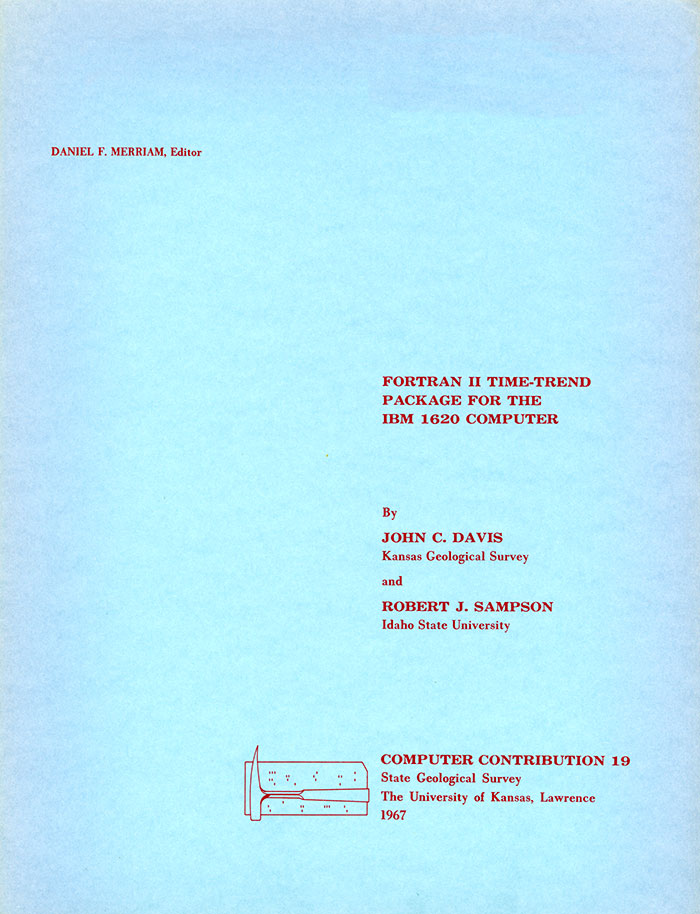
Kansas Geological Survey, Computer Contributions 19, originally published in 1967
1Kansas Geological Survey and 2Idaho State University

Originally published in 1967 as Kansas Geological Survey Computer Contributions 19.
Many types of geologic data are distributed serially, either through time or along a geographic coordinate. Although such data are ordered, it is seldom equally spaced, especially in the time sense. Geologic information that may be uniformly ordered through time (time series) includes that from varved sequences or annual growth of organisms, such as tree rings or bands on certain corals. Most other types of data, such as measurements of a stratigraphic succession, represent a nonuniform time series in which the length of the units are not known. In these instances, distance is used as an approximator of time, and the data sequence is considered as a geographic series. Other types of geographic series have no time connotation; examples include data collected along a traverse or information produced by a linear recorder attached to equipment such as an x-ray diffraction unit or infrared spectrometer.
Serial methods have been applied primarily in three types of investigation. They have been used for the extraction of components, in the examination for periodicity, and to obtain numerical approximations of sequences. Component extraction consists of curve fitting by various methods so that the data are separated into (1) an underlying "trend" and (2) superposed "noise" or error, which is a random component. Filtering of seismographic records to remove random fluctuations is an example of this application. More recently, data from stratigraphic sequences have been smoothed by curve fitting to aid in the detection of long-term trends.
Techniques borrowed from market analysis have been applied widely in the search for periodicity in oscillatory data. Autocorrelation has been used to examine oscillatory sedimentary sequences such as cyclothems in an attempt to objectively test the hypothesis of rhythmic sedimentation. Statistical tests are available for determining the validity of suspected trends in data and are useful in such diverse areas as stratigraphic analysis and prediction of crude-oil reserves.
One of the most recent innovations is the application of time-series statistics to problems of stratigraphic correlation. Although the data usually do not meet the criteria necessary for valid time series, stratigraphic correlations on the basis of such parameters as coded lithologies or drilling times have been successful. Most of these applications have utilized cross-correlation, cross-association, or related statistics. It is also possible to compare certain types of serial data by reducing the sequences to equations and clustering them on the basis of the similarity of their coefficients.
The accompanying series of programs are written in FORTRAN II for use on an IBM 1620 computer having 20K bits core storage. Restrictions in programs for this computer are typical of those inherent in older machines and also in a new generation of instruments such as the PDP-8, IBM 1130 and 1800, SDS Sigma 2, and other small computers. These machines are most generally available to geologists at smaller universities and in oil and mining company field offices. Even on campuses having large data-processing centers, many departments and agencies maintain small computers for their own instructional or routine use. They are usually the only type of computer available in many installations outside the United States. Persons having computers similar in characteristics to the IBM 1620 should find this collection of programs easily adaptable to their use.
Because of computer size restrictions, the different operations cannot be combined into a single large program with options. They are separated, therefore, into a series of independent programs capable of being used separately or in conjunction with one another. A "single" program with options in FORTRAN IV written for the GE 625 also is available. The following five programs constitute the package:
All programs require PDQ FORTRAN Processor C2 without reread version 1 modification 0, and PDQ FORTRAN fixed format subroutines without reread version 1 modification 0 (IBM User's Group Program 2.0.031) for operation on the IBM 1620. Minimal machine requirements consist of an IBM 1620 Model I central processing unit with 20K bits storage, automatic divide, and indirect addressing. A 1622 card read punch and a 407 accounting machine or similar line printer also are required. Examples of output are included in Appendix.
Read the PDF version (3.8 MB)
Kansas Geological Survey
Placed on web Sept. 4, 2019; originally published 1967.
Comments to webadmin@kgs.ku.edu
The URL for this page is http://www.kgs.ku.edu/Publications/Bulletins/CC/19/index.html